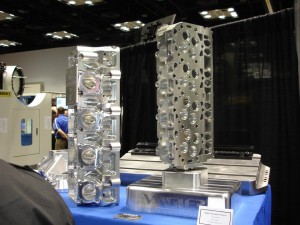A cylinder head is much more than a casting that tops off the block, holds the valves and forms the combustion chambers. The head works in combination with the camshaft, induction and exhaust systems to determine how the engine breathes, the engine’s power curve and personality. The “right” cylinder head on an engine will deliver peak power in the RPM range where you want it. The engine will have good throttle response and produce the kind of torque and horsepower numbers you want. Head selection, therefore, is a key ingredient in building a winning performance engine.
Let’s start with the basics. Assuming you are going to choose an aftermarket cylinder head, you have to find out what’s available for the engine you want to build. For popular engines like small block and big block Chevy, Ford and Chrysler engines, there are dozens of head configurations, brands and product lines from which you can choose. The selection can be so overwhelming that sometimes it comes down to eenie, meenie, minee, moe to pick a head.
Some people pick a set of cylinder heads based on name brand, previous experience or word-of-mouth recommendations. Some will shop around for the least expensive set of heads that promise to meet their expectations. Others will make their selection based strictly on which set of heads claims the highest air flow numbers. But there’s a lot more that should be considered when choosing a set of cylinder heads.
Determine The Venue
Price, performance and availability are all important considerations in the head selection process. But equally important is choosing a set of cylinder heads that are right for the engine and the application. Building a street performance engine is different than building a circle track engine, a drag engine, a marine engine, or a truck pull engine.
Each type of application has its own unique requirements, so the heads have to have the right flow characteristics for that application.
Basic considerations include such variables as engine displacement, compression ratio, camshaft lift and duration specifications, RPM range (where the engine should make the most horsepower and torque), and target horsepower (be realistic!).
You also need to consider vehicle weight, type of transmission (manual or automatic), torque converter stall speed (if automatic), gearing (transmission and differential), and most importantly the application itself (street, street/strip, drag, circle track, road race, off-road, etc.).
Street engines spend most of their time between idle and part throttle so they must have good low and mid-range torque and throttle response to be drivable — especially in heavier cars with automatic transmissions. For this type of application, you want a set of heads with stock to moderately larger intake runner volumes to keep air velocity high. Peak valve lift is probably going to be no more than about half an inch with a typical street cam, so a set of heads that claims huge airflow numbers at extreme valve lifts would not be your best choice. Too much head can be counter productive in this type of application.
A drag engine runs at full throttle for a quarter mile. For this kind of application, you want lots of valve lift, duration and airflow at high RPM. Bigger is better in terms of intake runner volumes, valve size and peak airflow numbers provided the engine has the cam, induction system and cubic inches (or boost pressure) to handle it.

